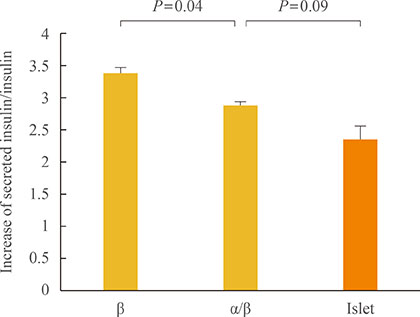Endocrinol Metab.
2015 Mar;30(1):92-97. 10.3803/EnM.2015.30.1.92.
Co-Culture of alpha TC-6 Cells and beta TC-1 Cells: Morphology and Function
- Affiliations
-
- 1Department of Internal Medicine, Inje University College of Medicine, Busan, Korea. kmkdoc@hanmail.net
- 2Moelcular Therapy Lab, Paik Memorial Institute for Clinical Research, Inje University, Busan, Korea.
- KMID: 2407110
- DOI: http://doi.org/10.3803/EnM.2015.30.1.92
Abstract
- BACKGROUND
In vitro experiments using only beta-cell lines instead of islets are limited because pancreatic islets are composed of four different types of endocrine cells. Several recent studies have focused on cellular interactions among these cell types, especially alpha- and beta-cells. Because islet isolation needs time and experience, we tested a simple co-culture system with alpha- and beta-cells. Their morphology and function were assessed by comparison to each single cell culture and pancreatic islets.
METHODS
alpha TC-6 cells and beta TC-1 cells were maintained in Dulbecco's Minimal Essential Medium containing 5 mM glucose and 10% fetal bovine serum. Cells were mixed at a 1:1 ratio (5x10(5)) in 6-well plates and cultured for 24, 48, and 72 hours. After culture, cells were used for insulin and glucagon immunoassays and tested for glucose-stimulated insulin secretion (GSIS).
RESULTS
alpha TC-6 and beta TC-1 cells became condensed by 24 hours and were more strongly compacted after 48 hours. beta TC-1 cells showed both beta-beta and beta-alpha cell contacts. GSIS increased with increasing glucose concentration in co-cultured cells, which showed lower secreted insulin levels than beta TC-1 cells alone. The increase in the secreted insulin/insulin content ratio was significantly lower for co-cultured cells than for beta-cells alone (P=0.04). Compared to islets, the alpha-/beta-cell co-culture showed a higher ratio of GSIS to insulin content, but the difference was not statistically significant (P=0.09).
CONCLUSION
alpha TC-6 and beta TC-1 cells in the co-culture system showed cell-to-cell contacts and a similar stimulated insulin secretion pattern to islets. The co-culture system may be used to better mimic pancreatic islets in in vitro assessments.
Keyword
MeSH Terms
Figure
Reference
-
1. Meda P. Protein-mediated interactions of pancreatic islet cells. Scientifica (Cairo). 2013; 2013:621249.2. Scharfmann R, Rachdi L, Ravassard P. Concise review: in search of unlimited sources of functional human pancreatic beta cells. Stem Cells Transl Med. 2013; 2:61–67.3. Chapter 1, Architecture of pancreatic islets. In : Seino S, Bell GI, editors. Pancreatic beta cell in health and disease. Berlin: Springer;2008. p. 3–11.4. Ravassard P, Hazhouz Y, Pechberty S, Bricout-Neveu E, Armanet M, Czernichow P, Scharfmann R. A genetically engineered human pancreatic beta cell line exhibiting glucose-inducible insulin secretion. J Clin Invest. 2011; 121:3589–3597.5. Bergsten P, Hellman B. Glucose-induced amplitude regulation of pulsatile insulin secretion from individual pancreatic islets. Diabetes. 1993; 42:670–674.6. Gilon P, Ravier MA, Jonas JC, Henquin JC. Control mechanisms of the oscillations of insulin secretion in vitro and in vivo. Diabetes. 2002; 51:Suppl 1. S144–S151.7. Tengholm A, Gylfe E. Oscillatory control of insulin secretion. Mol Cell Endocrinol. 2009; 297:58–72.8. Kelly C, McClenaghan NH, Flatt PR. Role of islet structure and cellular interactions in the control of insulin secretion. Islets. 2011; 3:41–47.9. Bosco D, Haefliger JA, Meda P. Connexins: key mediators of endocrine function. Physiol Rev. 2011; 91:1393–1445.10. Renold AE, Zahnd GR, Wollheim CB. Chapter 3, Intercellular communication and insulin secretion. Contributions of physiology to the understanding of diabetes. Berlin: Springer;1997. p. 24–42.11. Bavamian S, Klee P, Britan A, Populaire C, Caille D, Cancela J, Charollais A, Meda P. Islet-cell-to-cell communication as basis for normal insulin secretion. Diabetes Obes Metab. 2007; 9:Suppl 2. 118–132.12. Potolicchio I, Cigliola V, Velazquez-Garcia S, Klee P, Valjevac A, Kapic D, Cosovic E, Lepara O, Hadzovic-Dzuvo A, Mornjacovic Z, Meda P. Connexin-dependent signaling in neuro-hormonal systems. Biochim Biophys Acta. 2012; 1818:1919–1936.13. Hamaguchi K, Utsunomiya N, Takaki R, Yoshimatsu H, Sakata T. Cellular interaction between mouse pancreatic alpha-cell and beta-cell lines: possible contact-dependent inhibition of insulin secretion. Exp Biol Med (Maywood). 2003; 228:1227–1233.14. Hopcroft DW, Mason DR, Scott RS. Structure-function relationships in pancreatic islets: support for intraislet modulation of insulin secretion. Endocrinology. 1985; 117:2073–2080.15. Meda P, Halban P, Perrelet A, Renold AE, Orci L. Gap junction development is correlated with insulin content in the pancreatic B cell. Science. 1980; 209:1026–1028.16. Trimble ER, Halban PA, Wollheim CB, Renold AE. Functional differences between rat islets of ventral and dorsal pancreatic origin. J Clin Invest. 1982; 69:405–413.17. Leite AR, Carvalho CP, Furtado AG, Barbosa HC, Boschero AC, Collares-Buzato CB. Co-expression and regulation of connexins 36 and 43 in cultured neonatal rat pancreatic islets. Can J Physiol Pharmacol. 2005; 83:142–151.18. Brereton H, Carvell MJ, Persaud SJ, Jones PM. Islet alpha-cells do not influence insulin secretion from beta-cells through cell-cell contact. Endocrine. 2007; 31:61–65.
- Full Text Links
- Actions
-
Cited
- CITED
-
- Close
- Share
- Similar articles
-
- In silico approach to calculate the transcript capacity
- Comparison of Tc-99m MAG, and Tc-99m DTPA Renal Scans in Patients with Upper Urinary Tract Obstruction
- Mineralization-inducing potentials of calcium silicate-based pulp capping materials in human dental pulp cells
- Effect of Multidrug Resistance Gene-1 (mdr1) Overexpression on In-Vitro Uptake of 99mTc-sestaMIBI in Murine L1210 Leukemia Cells
- Different Uptake of Tc-99m ECD and Tc-99m HMPAO in the Normal Brains - Analysis by Statistical Parametric Mapping







